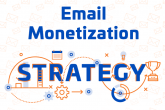Think of all the newsletters you’ve created — the hours that went into developing your quality content and picking out the very best subject lines. Now think about what your most successful email newsletters had in common. Was it the compelling subject lines that encouraged engagement, or maybe a clear call-to-action?
If some of your newsletters have higher open rates and click-through rates than others, and you’re not sure why that is, it’s time to do some research.
There’s a clear link between a good CTR (click-through rate) and effective email monetization. Taking full advantage of your email list and generating revenue through newsletters requires using the latest email marketing strategies.
Engaging Newsletters Have Higher Click-Through Rates
The best email newsletters have high open rates and click-through rates. Average email open rates are now at just over 20%, while click-through rates are at 2.4%. If you’re seeing open rates and click-through rates that are much lower than these averages, it’s time to look at why that might be.
Take a peek at your email analytics for insights into how your newsletters are stacking up. The key metrics you should be tracking are click-through rate, open rate, conversion rate, bounce rate, and email sharing and/or forwarding rate. These metrics will play a big role in your ability to monetize emails. Of these five email metrics, the CTR is the most important.
What Is a Click-Through Rate?
The click-through rate is the percentage of readers (email recipients) who clicked on a link in an email. You can calculate the CTR in your email newsletters by taking the total number of clicks (or unique clicks), dividing that by the number of delivered emails, and then multiplying that number by 100.
Average newsletter click-through rates vary by industry, however, you should be seeing a click-through rate of at least 2% to 3%.
There’s a reason why marketers care so much about click-through rates. More than any other email metric, click-through rate can help you evaluate how readers are responding to your newsletters. Nevertheless, having a CTR that’s higher than 2% to 3% means readers are heavily engaging with the content you send out. On the other hand, having a CTR that’s lower than industry benchmarks is a signal that some changes are necessary if you want to continue growing your email list.
What Is an Open Rate?
Open rates and click-through rates go hand-in-hand. After all, readers can’t click on the links in your newsletters if they don’t open them first.

The term “open rate” refers to the percentage of recipients who open a given newsletter. And it’s one of the most straightforward metrics since we’re not measuring how engaged readers were or how much content they consumed before clicking away from an email. With open rate, we’re simply measuring how many recipients opened up your email newsletter.
Regardless of your industry, it’s important that you work to improve the open rates on your email newsletters. On average, most marketers see email open rates somewhere between 15% and 20%.
Open rates are most valuable when they’re used as a comparative metric. Rather than focusing on the percentage of recipients who opened your email on a single day, try expanding your view and comparing the open rates on a dozen or so newsletters. Which days had the highest open rates, and what did the newsletters with the highest open rates have in common?
Tips To Improve Newsletter Open Rates
Now that we have established which metrics you should be tracking if you want to improve your newsletters, it’s time to start thinking about how you can improve those metrics.
If you want to monetize emails, you need to have high open rates and click-through rates. Start tracking these metrics over time using a tool like inboxAds, which distills the most important email metrics and displays the data in easy-to-read graphs.
Below, you’ll find four guaranteed strategies to improve your newsletter open rate and CTR (click-through rate).
Top Strategies for Increasing Newsletter Open and Click-Through Rate
#1. Compelling Subject Lines. The first thing people see when they look at your newsletter is the subject line. Make sure your subject lines are short and sweet. The goal here is to come up with a subject line that recipients can’t help but click. Stay away from emojis. Personalize the subject line whenever possible. Tell people what’s inside. Above all else, keep close tabs on the impact of any new subject line styles by running A/B testing and tracking which subject lines generate the greatest open rates.
#2. Clear Call-To-Action. What do you want readers to do when they open your newsletter? If you’re not clear on the action you want, then your readers probably aren’t clear, either. If the goal of your newsletter is generating revenue, then you need to be directing readers to a website where they can sign-up, subscribe, or purchase whatever it is you’re selling. The point here is to drive consumers to action, so make sure the link you include in your CTA is visible and eye-popping.
#3. Impactful Images. We could sit here and debate the merits of including images in email newsletters. Some people say images make newsletters more engaging, other people say image-heavy emails are more likely to get caught up in spam filters. Regardless of where you come down on the issue, there’s no getting around the fact that images lead to more engaging newsletters. Newsletters with images have a 42% higher CTR compared to those with text-only. Including alt text for all the images you include in your emails is one way to ensure recipients who aren’t able to see on-screen images still have a clear understanding of what’s inside.
#4. Optimization for Mobile. Industry research shows that almost half of all emails (46%) are now opened on mobile devices. That’s huge. However, if your emails aren’t displaying properly on mobile, then nearly half of all recipients are losing out on your content. If the ads in your newsletter aren’t displaying correctly, you’re missing out on valuable revenue, too. The concern over mobile optimization is one reason why more marketers are using platforms like inboxAds, which select the content that recipients receive depending on their preferences and previous activities. Sending custom-tailored content leads to higher click-through rates and open rates, which email publishers love.

It’s worth mentioning that you might not hit a home run every time you change up your email newsletter. Therefore, run A/B testing to determine which improvements are generating the greatest gains as you work toward more effective email monetization.
The Bottom Line?
Before you can start generating revenue from newsletters, you need to have a product that people are opening and engaging with. Click-through rates and open rates both play an important role in being able to effectively monetize email newsletters. To learn even more about the latest tools for maximizing revenue from email newsletters in 2020, check out inboxAds and take a look at how the user interface and the natural user experience makes it easier to send higher-quality emails.






